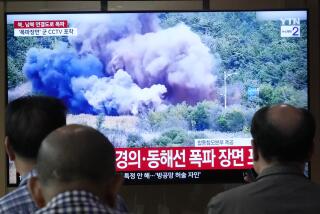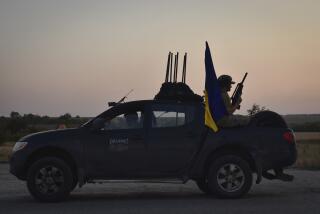Ex-GIs Tell of More Korean Civilian Deaths
- Share via
On a single day in August 1950, six weeks into the Korean War, a U.S. general and other Army officers ordered the destruction of two strategic bridges as South Korean refugees streamed across, killing hundreds of civilians, according to former soldiers, Korean witnesses and U.S. military documents.
Ex-GIs told of the bridge demolitions and two other incidents, machine-gun and mortar attacks on refugees, during interviews about what happened at No Gun Ri, South Korea, in late July 1950. In that case, which was first reported by the Associated Press on Sept. 29, veterans corroborated Korean accounts of hundreds of refugees having been killed at U.S. hands. The Defense Department has opened an investigation into the events at No Gun Ri.
One bridge blast, with its refugee deaths, was recorded briefly in an official Army chronicle, but not until 10 years after the event.
The trail of dead civilians, many of them women and children, has been a hidden underside to a well-known chapter in U.S. military history: the southward retreat from advancing North Korean forces of three Army divisions into a defensible perimeter across South Korea’s Naktong River in July-August 1950.
Confusion Marked Army’s Withdrawal
The withdrawal across the Naktong River was an often confused retreat. The U.S. Army told South Korean civilians, citizens of an allied nation, to head south. But declassified Army documents show that U.S. commanders also issued standing orders to shoot civilians along the war front to guard against North Korean soldiers disguised in the white clothes of Korean peasants. Military lawyers call those orders illegal.
Just days into his first combat command, the 1st Cavalry Division’s Maj. Gen. Hobart R. Gay told reporters he was sure most of the white-clad columns pressing toward American lines were North Korean guerrillas.
“We must find a means to hold these refugees in place,” the division commander said.
Days later, on Aug. 3, 1950, Gay waited at the Naktong River as his division retreated across the bridge at Waegwan, the last crossing open to North Korean units reported massing more than 15 miles to the west. His troops had failed in repeated efforts to turn back refugees, even firing warning shots over their heads.
“Finally, it was nearly dark,” Gay later wrote to an Army historian. “There was nothing else to be done.”
Gay ordered the bridge blown. The preset charges shattered the supports and dropped one of the bridge’s spans into the river.
“It was like a slow-motion movie,” remembered ex-lieutenant Edward L. Daily of Clarksville, Tenn. “All those refugees went right down into the river.”
“It was a tough decision,” Gay wrote to the historian, “because up in the air with the bridge went hundreds of refugees.”
Refugees’ Deaths Appear in ’60 Account
The division’s 1950 war diary did not report the refugees’ deaths. But the later narrative by Gay, who died in 1983, led to a brief mention in an official war history published in 1960.
What happened earlier that August day, however, 25 miles downriver at Tuksong-dong village, has never been reported.
Carroll F. Kinsman, a former sergeant, remembers the streams of white-clad humanity shuffling across the 650-foot-long Tuksong-dong bridge--women clutching children, old men, overloaded ox carts.
“We stayed up all that night and searched them,” said Kinsman, a veteran of the 14th Combat Engineers Battalion. They found no infiltrators, he said.
Retreating Americans had not yet sighted North Korean units near the river around Tuksong-dong on Aug. 3, the declassified record shows. But American officers knew the enemy would arrive eventually. Pressed by a timetable, they proved unable to keep the refugees back from the bridge, rigged for instant demolition.
Soldiers fired over the heads of those crowding across and tried to warn them the bridge would be blown up, said the veterans.
“They tried to stop the refugees from coming across, and they wouldn’t stop. They were abutment to abutment,” ex-engineer Leon L. Denis of Huntsville, Ala., recalled in an interview before his death Aug. 31.
The men of Company A, 14th Engineers, had taken two days to set 7,000 pounds of explosives on the steel-girder bridge. When the detonation order came at 7:01 a.m., “it lifted up and turned it sideways and it was full of refugees end to end,” said Kinsman, of Gautier, Miss.
“These people were on the bridge, and you saw the spans of steel flying and you knew they were killed,” said veteran Rudolph Giannelli of Port St. Lucie, Fla., driver for Col. Richard W. Stephens, the 21st Infantry Regiment commander who was the last officer across the bridge.
In separate interviews, Kinsman, Denis and Giannelli said hundreds of civilians were killed. Ex-Army engineer Joseph M. Ipock of Jackson, N.J., said he could see only 30 or 40 refugees from his vantage point.
Kim Bok Jong, 73, a South Korean who said he was 200 yards from the bridge, out of view around a hill, remembered that “people rushed back toward us and said many people died when the Americans blew up the bridge.”
The veterans said they don’t know who gave the detonation order at Tuksong-dong. The operation was noted in the 14th Engineers report with a simple “Results, excellent.”
From the bridges, the U.S. Army units moved into defensive positions along the Naktong. They had arrived at the river after weeks of retreat through South Korea--and after countless, sometimes bloody encounters with refugees.
‘We Got Orders to Eliminate Them’
Four 1st Cavalry Division veterans said that on Aug. 2, the day before the bridges were blown up, they were among several dozen soldiers retreating toward the Naktong and being trailed by perhaps 80 white-clad Koreans.
In midafternoon, five North Korean soldiers disguised in white appeared, they said. Daily said the North Koreans opened fire and were quickly killed. Another veteran, Eugene Hesselman, remembered it differently, saying the intruders surrendered and were led away.
Because it was believed they came from among the refugees, said Hesselman, of Fort Mitchell, Ky., “we got orders to eliminate them [the refugees]. And we mowed them all down. The Army wouldn’t take chances.”
Scattering too late, every man, woman and child was killed, Daily said. He and veteran Robert G. Russell said they found about 10 disguised North Korean soldiers among the dead. Hesselman said he doesn’t recall that infiltrators were found.
About a week earlier, half a dozen 1st Cavalry Division veterans recounted, mortar fire was directed at possibly a few hundred refugees moving down a railroad track about 100 miles southeast of Seoul.
Americans had been ambushed the night before by North Koreans who mingled with refugees, said former soldier James McClure. Now, he said, he spotted another white-clad group, including women and children, through his binoculars and put in a call to a command post.
“The colonel contacted mortar and decided to kill them instead of allowing them through the line,” said McClure, of Federal Way, Wash. He could not recall the colonel’s name.
Veteran Henry Matthias of Baltimore said he believes about 70 refugees were killed.
*
Associated Press researcher Randy Herschaft contributed to this report.
(BEGIN TEXT OF INFOBOX / INFOGRAPHIC)
Deadly Bridge Explosions
Early in the Korean War, hundreds of South Korean civilians were killed when the U.S. Army blew up two bridges as refugees crossed.
*
This account is according to U.S. veterans, Korean witnesses and U.S. military documents.
More to Read
Sign up for Essential California
The most important California stories and recommendations in your inbox every morning.
You may occasionally receive promotional content from the Los Angeles Times.













